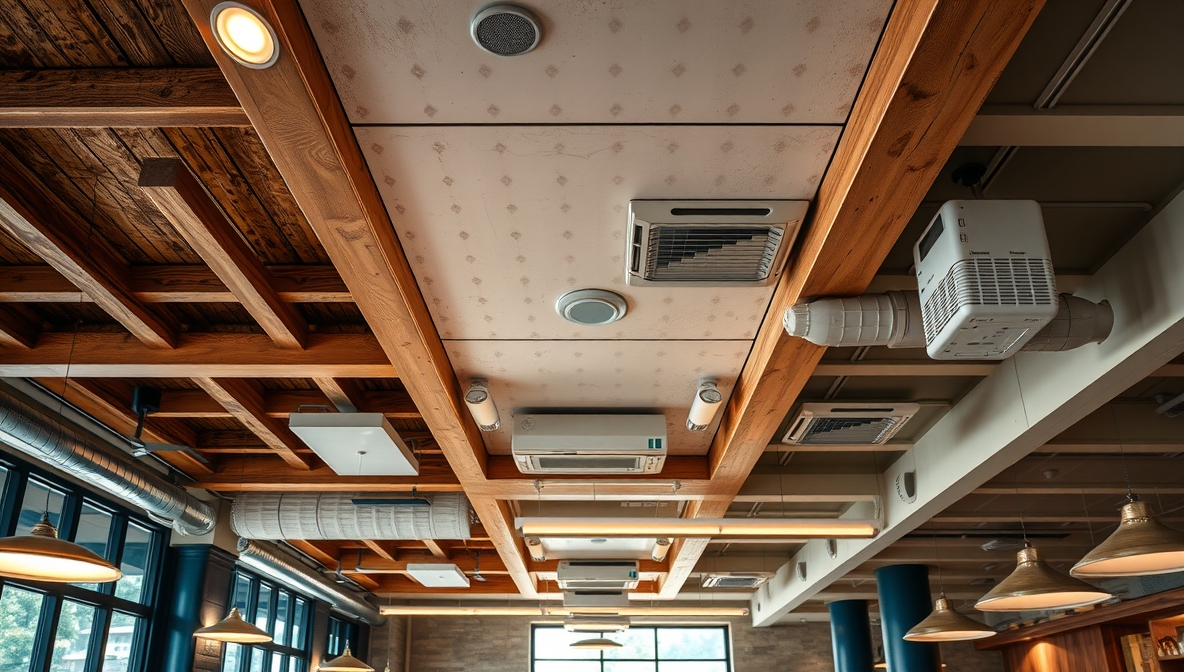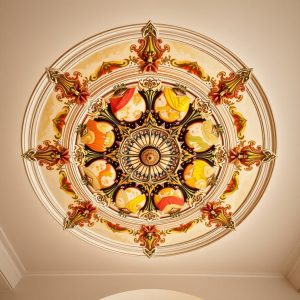
DIY Ceiling Ideas That Instantly Elevate Any Room

A ceiling holds the power to define the entire vibe of a room. Plain white surfaces often fade into the background, but a little creativity brings them to life. Bold paint colors, intricate wood paneling, and unexpected materials can turn that forgotten fifth wall into a stunning focal point.
Wood beams introduce rustic charm, while metallic tiles reflect light and add a touch of luxury. For a modern touch, geometric patterns or bold wallpaper prints create instant drama. Stenciled designs offer a budget-friendly way to showcase artistic flair without the need for professional help.
Statement lighting plays a major role as well. Oversized chandeliers or clusters of pendant lights draw eyes upward, emphasizing the ceiling’s new design. Incorporating elements like coffered grids or exposed pipes adds architectural interest that feels custom-made.
A well-designed ceiling doesn’t just decorate; it alters the entire experience of the space. With a bit of imagination and the right materials, every room can gain a unique character that reflects personal style and creativity.
10 DIY Ceiling Ideas
The ceiling often gets ignored. Most people focus on walls and floors. But the ceiling offers a large canvas for creativity. With a little work, any ceiling can change the feel of a room. Here are ten DIY ceiling ideas to try.
1. Painted Ceiling

Paint brings life to any ceiling. A fresh coat of paint changes the entire vibe of a room. Choose a color that matches your walls and furniture. Light colors make a room feel bigger. Dark shades create a cozy, warm feeling. Use high-quality paint to avoid streaks. For a fun twist, try a pattern like stripes or a two-tone design. Always clean the ceiling first. Use a primer for better results. Paint slowly to avoid drips. Once done, your ceiling will look fresh and new.
2. Wood Planks
Wooden ceilings add warmth and charm. Use tongue-and-groove planks or reclaimed wood for a rustic look. Measure your ceiling and buy the right amount of wood. Use a nail gun to fix the planks to the ceiling beams. Stain or paint the wood to match your style. A wood ceiling makes a room feel cozy and natural. Always wear safety gear while working overhead. Secure each plank tightly for a neat finish.
3. Faux Beams

Faux beams give a room a rustic or modern look. They are lighter and easier to install than real beams. Choose beams that fit your room size and ceiling height. Use strong adhesive and screws to fix them. Faux beams can be stained or painted. They create a high-end look without high costs. Measure carefully before cutting the beams to fit. A helper makes installation easier and safer.
4. Beadboard Panels
Beadboard offers a classic, cottage-style look. It works well in kitchens, bathrooms, and bedrooms. Measure the ceiling area first. Cut the beadboard panels to size. Use adhesive and finishing nails to attach them. Fill gaps with caulk for a seamless look. Paint or stain the beadboard to match your decor. This project can usually be done in a weekend. Beadboard ceilings add texture and interest.
5. Tin Tiles

Tin ceiling tiles create a vintage feel. They come in many patterns and finishes. Clean and prep the ceiling first. Use adhesive and nails to attach the tiles. Some tiles snap together easily. Paintable options let you match any color scheme. Tin tiles reflect light, making rooms brighter. Wear gloves to avoid cuts when handling metal tiles. Measure and plan your layout before starting.
6. Stenciled Design
Stencils add unique patterns without much cost. Buy a stencil that fits your room style. Clean the ceiling and apply a base coat of paint. Use painter’s tape to hold the stencil in place. Apply paint with a roller or sponge. Let each section dry before moving the stencil. Repeat the pattern across the ceiling. Stenciling takes patience but gives a custom look. Use soft colors for a subtle design or bold colors for impact.
7. Coffered Ceiling

A coffered ceiling adds depth and elegance. Build a grid of beams across the ceiling. Use MDF boards or real wood. Secure them with nails and adhesive. Fill gaps with caulk. Paint the beams and ceiling for a polished look. This project needs careful planning and measuring. A coffered ceiling makes a big impact in living rooms and dining areas.
8. Fabric Panels
Fabric adds softness and color to a ceiling. Stretch fabric panels across the ceiling for a tent-like feel. Use lightweight fabric for easy handling. Attach the fabric to wooden frames or directly to the ceiling with staples or adhesive strips. This idea works well in bedrooms or playrooms. Choose patterns and colors that match your room. Make sure the fabric is fire-resistant for safety.
9. Wallpapered Ceiling

Wallpaper isn’t just for walls. Apply it to ceilings for a bold statement. Choose light, peel-and-stick wallpaper for easy work. Clean the ceiling and mark guidelines. Start from the center and smooth the wallpaper outward. Use a smoothing tool to remove bubbles. Trim edges neatly for a clean finish. Wallpapered ceilings draw the eye upward and make rooms feel special.
10. Exposed Pipes and Ducts
In industrial-style homes, exposed pipes add character. Clean and paint the pipes to match your decor. Use metallic or matte finishes for a modern look. Arrange lighting around the pipes for extra style. Secure all pipes properly to avoid safety risks. This idea works best in lofts, basements, or modern apartments. Exposed ceilings bring an edgy, urban feel to any space.
FAQs
How hard is it to DIY a ceiling?
It depends on the project. Simple painting or wallpapering is easier. Projects like coffered ceilings or faux beams need more skill and tools.
Do I need a permit for ceiling projects?
Most simple updates don’t need permits. Major changes like adding beams or removing structures may require approval. Always check local rules.
Can I mix ceiling ideas?
Yes. For example, you can combine paint with stencils or add faux beams over beadboard. Mixing styles can create a custom look.
What safety steps should I follow?
Always use safety gear like goggles and gloves. Use sturdy ladders. Work with a partner for harder tasks. Follow tool instructions carefully.
How much do DIY ceiling projects cost?
Costs vary. Painting may cost under $100. Wood planks, beams, or tin tiles can cost several hundred dollars. Plan your budget before starting.
Conclusion
A ceiling can change how a room feels. With simple tools and some effort, any ceiling can become a feature. From painted designs to exposed pipes, the options are wide. Always plan carefully, use the right tools, and stay safe. Start with one idea and see how much it transforms your space.
